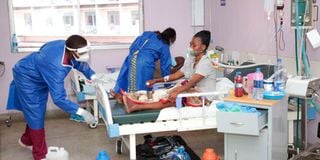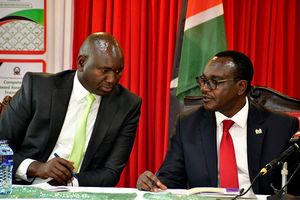Premium
Green shoots on the Kisumu Covid war zone

Health workers attend to a patient recuperating from Covid-19 at Jaramogi Oginga Odinga Teaching and Referral Hospital in Kisumu County on June 10, 2021. Kisumu County has recently experienced a surge in Covid-19 cases with isolation centers and mortuaries filled to capacity.
What you need to know:
- There is also a lot to be hopeful about Kisumu’s current battle with Covid-19.
- It has jolted Governor Anyang’ Nyong’o’s government into action.
The first case of Covid-19 in my Kokello village in Kajulu East was confirmed last week. The patient, a woman in her 50s, tested positive for the coronavirus at Gita Hospital, about 5km off the Mamboleo-Muhoroni Road.
She had visited the nearby hospital complaining about ‘some small malaria’, as my people tend to describe every other disease presenting fever and other malaria-like symptoms. News of a patient next door will no doubt entrench the Covid-19 scare among the village folks I reported in this column last Sunday.
It will also reinforce suspicions about community transmission around Kisumu town, the epicentre of the current wave of Covid-19 in western Kenya.
Kisumu drew the attention of global pandemic hunters last month when some factory workers at Kibos were found with the Indian variant of the coronavirus.
But there is also a lot to be hopeful about Kisumu’s current battle with Covid-19. It has jolted Governor Anyang’ Nyong’o’s government into action, a remarkable departure from the hints of denialism days to the June 1 Madaraka Day celebrations in the town.
Last week, the governor imposed enhanced containment measures, including a crackdown on public transport and social-gathering breaches.
Sustained enforcement
Going by the recent success of similar measures in Nairobi, for instance, sustained enforcement should help reduce Kisumu’s high positivity rates significantly in the coming weeks.
The scale-up of testing deeper into the villages has probably handed the county its best chance of overcoming the pandemic crisis.
World Health Organization (WHO) director-general Tedros Adhanom Ghebreyesus in March 2020 likened slow testing for Covid-19 to fighting a fire blindfolded.
In addition to the obvious related benefits around contact tracing, isolation and treatment, having more people tested will help increase awareness levels and discourage dangerous behaviour.
As they love to say here in Dholuo, ng’ech neno gi wang’e – a monitor lizard (presumably deaf) has to see danger first before it can react.
Nothing demonstrates this slowness to react to danger better than TV footage of a middle-aged man in Awendo telling reporters early last year that they would have to see coronavirus kill one or two people in their neighbourhood before they could believe its existence.
After 15 months of Covid-19 in Kenya, a majority of people no longer deny the disease, thanks to the enforcement of disruptive containment measures and the awareness campaigns over that period.
Deeply entrenched cultures and social habits pose challenges for public health campaigns in the villages, though. My Nyumba Kumi source back in the village tells me they are having quite some difficult time trying to convince folks to avoid shaking hands or stopping by a homestead to chat up a relative or friend on the way from the farm, for example.
There are green shoots on the Kisumu Covid battlefront, but public health people have their work cut out.
[email protected]. @otienootieno





